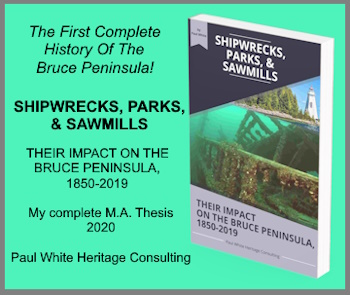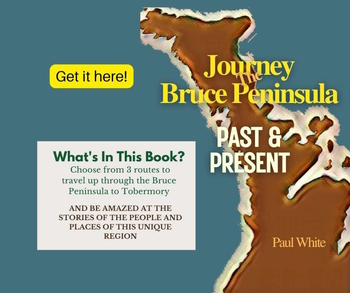Bruce Peninsula
Towns & Villages
Access to transportation routes has been key to the creation and development of Bruce Peninsula towns and villages. The peninsula did not open for settlement until the 1854 treaty was signed with the Saugeen Ojibwa nation. But it was not until land, and crown timber lease auctions were held in the late 1850s and early 1860s that settlement in the region began in earnest.
The demand for colonial timber products began in the early 1800s. Britain needed large amounts of wood to build and maintain its armada of naval vessels. As the forests of the Atlantic coast and the St. Lawrence River valley were depleted of quality timber the lumbermen moved north to the forests along the Ottawa River. Gradually, they headed west through the “Nipissing Gap.” This route was known to early fur traders as an efficient path to the interior of the continent. Once the forests of the Mattawa River, Lake Nipissing, and French River region could no longer sustain the demands of the British market, and emerging colonial markets, lumbermen cast covetous eyes on the virgin forests of the unsettled Bruce Peninsula.
The Bruce Peninsula was the last region of significant size in southern Ontario to be settled. Consequently, when the first settlers and the lumbering companies arrived on the peninsula their only means of travel were either on foot through dense forests following rough-hewn trails used by the Indigenous peoples of the area, or via vessels bringing them to either the Lake Huron or Georgian Bay shorelines.
The first Bruce Peninsula towns and villages were created to meet the needs of the lumbering industry. Sawmills, located on rivers or streams that could generate a source of power, were the first need of the forest products industry, followed closely by the need for good harbour locations. As some of these locations grew, service industries were established, to assist not only the forest products industry, but also local settlers. Some communities grew larger than others for reasons such as a better harbour facility, and numbers of services offered to the hinterland regions.
Bruce Peninsula towns and villages such as Tobermory at the northern tip of the peninsula have prospered despite the demise of the region's timber trade. Tourism has become a driving force for the economies of many towns and villages that originated as lumbering communities. While tourism has become an important part of the economy of the peninsula, other centres, such as Wiarton and Owen Sound, have become regional hubs of influence. Along the southern limits of the peninsula towns and villages such as Allenford, Elsinore, Hepworth, and Parkhead have become commuter communities for the two larger centres in the region, Owen Sound and Wiarton.
Journey the Bruce Peninsula Past & Present which is available by clicking the link.
Below, there are links to stories about the various communities that dot the peninsula. And, if you are looking for a book detailing routes from the southern end of the peninsula to the northern tip. And, if you would like to read interesting stories about the places that you are passing through check out my latest book, Journey the Bruce Peninsula Past & Present makes a great travel companion as you travel this unique part of Canada's Great Lakes region.
Bruce Peninsula Towns & Villages
Towns & Villages: The first Bruce Peninsula towns and villages had a source of water power to run sawmills and a good harbour to ship forestry products to market.
The 12th of July and Dominion Day Celebrations on the Bruce Peninsula were an outlet from the everyday drudgery of life for pioneers on the Bruce Peninsula.
Allenford United Church history details some important information about that community's church but also about one of the founders of this Ontario community.
A Pioneer Community: Driftwood Crossing (now Allenford): at the southern-most part of the Saugeen/Bruce Peninsula was at the midpoint between the Georgian Bay and Lake Huron coasts.
Land Auction in Amabel Township provided the opportunity for settlers to purchase land and begin a new life in Bruce County. On July 18, 1856, a notice signed by R.T. Pennefather, superintendent general the Indian Department, announced the public auction sale of 144,000 acres of land in the new townships of Amabel and Keppel.
Barrow Bay Ontario: a Picturesque Georgian Bay Community owes its origin to the once-thriving Bruce Peninsula lumbering industry. Today it is a quiet summer get-away!
Bruce Peninsula Municipal Politics: No matter what the venue, or the issue, seldom is a decision made that suits everyone.
Bruce Peninsula Newspapers Rivalry between the Wiarton Echo and Owen Sound newspapers promoting their communities was often vitriolic and led to acrimony between the two communities.
Dyer's Bay Ontario: Began as a lumbering settlement but may also have been one of the earliest points on the Bruce Peninsula to be visited by French explorers.
Elsinore Ontario: In the mid-1850s the first settlers arrived in the area just west of Allenford. However, it was not until 1865 when the North Gravel Road, or Highway 21 as it known today, was built that the village of Elsinore was established.
Hepworth Ontario: The early history of Hepworth is tied to two essential commodities, sawmilling and transportation. How Hepworth got its name is also an interesting story.
Lion's Head remained an important lumbering centre into the twentieth century. Today it is a centre of tourism, and the lion's head still guards the southern entrance to the bay. However, the same elements that created the image have continued to erode the rocky outcropping.
Park Head was an important Grand Trunk Railway depot on the Bruce Peninsula.
Sauble Beach: This popular beach in the 1950s was called Canada's Daytona Beach.
Sauble Beach Ontario is one of the most popular summer resorts in the province of Ontario. It welcomed its first summer visitors in the late 1800s and as continued to grow in popularity since that time.
Stokes Bay welcomed fishermen as their first non-native visitors. Today, if you are a fisherman, you will also probably want to try your luck landing a walleye, lake trout or any of the other game fish that live in the coastal waters of Lake Huron.
Tobermory Ontario has a rich history and, is the northern- most destination point for travellers visiting the world famous Bruce Peninsula.
Tobermory Ontario Tourism is focused on Fathom Five National Marine Park, Bruce Peninsula National Park, and, shipwreck diving which has become so popular that tourism has become an important part of that community's economy.
Tobermory Pioneers were first the fishermen who came to reap the rewards of the fishing-rich waters at the top of the peninsula.
Tupper Murray was one of the first names given to the community at the top of the Bruce Peninsula
Wiarton Ontario was known for its excellent natural harbour. It seemed to be a natural choice for the location of a port community. Colpoys Bay offered a natural harbour refuge for sailing vessels from storms on the often-tumultuous waters of Georgian Bay. As well, the harbour was located at the portage route across the base of the Bruce ...
Wiarton had Ambitions to Succeed but while success brought them a railroad and other ventures, one attempt did not have a sweet ending for many in the town.
Wiarton News: 1897 Town Council Report. By 1897 Wiarton was an established community and was experiencing some of the growing pains consistent with a community which was constantly expanding its physical borders. A November 1897 Wiarton council meeting reveals some the problems which that community was facing.
Wiarton Beet Industry: Wiarton's Sweet Enterprise Turns Sour! In their attempts to diversify Wiarton's economic base, a dramatic new industry was incorporated in 1896. Originally called the Owen Sound Sugar Manufacturing Company, the Wiarton Beet Sugar Manufacturing Company looked like it would have a large impact on the economy of the Wiarton area.
Wiarton Ontario's First Newspaper: The Echo viewed itself not only as a messenger of the news of the day, but also as a medium to promote the development of the interests of the Bruce Peninsula, and more particularly those of Wiarton.





